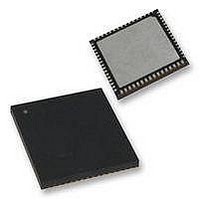PIC18F65K90T-I/MR Microchip Technology, PIC18F65K90T-I/MR Datasheet - Page 129

PIC18F65K90T-I/MR
Manufacturer Part Number
PIC18F65K90T-I/MR
Description
32kB Flash, 2kB RAM, 1kB EE, NanoWatt XLP, LCD 64 QFN 9x9x0.9mm T/R
Manufacturer
Microchip Technology
Series
PIC® XLP™ 18Fr
Datasheet
1.PIC18F66K90-IMR.pdf
(570 pages)
Specifications of PIC18F65K90T-I/MR
Processor Series
PIC18F
Core
PIC
Data Bus Width
8 bit
Program Memory Type
Flash
Program Memory Size
32 KB
Data Ram Size
2 KB
Interface Type
I2C, SPI
Maximum Clock Frequency
64 MHz
Number Of Timers
8
Operating Supply Voltage
1.8 V to 5.5 V
Maximum Operating Temperature
+ 125 C
3rd Party Development Tools
52715-96, 52716-328, 52717-734, 52712-325, EWPIC18
Minimum Operating Temperature
- 40 C
On-chip Adc
12 bit, 16 Channel
Core Processor
PIC
Core Size
8-Bit
Speed
64MHz
Connectivity
I²C, LIN, SPI, UART/USART
Peripherals
Brown-out Detect/Reset, LCD, POR, PWM, WDT
Number Of I /o
53
Eeprom Size
1K x 8
Ram Size
2K x 8
Voltage - Supply (vcc/vdd)
1.8 V ~ 5.5 V
Data Converters
A/D 16x12b
Oscillator Type
Internal
Operating Temperature
-40°C ~ 85°C
Package / Case
64-VFQFN Exposed Pad
Lead Free Status / Rohs Status
Details
- Current page: 129 of 570
- Download datasheet (5Mb)
10.0
Members of the PIC18F87K90 family of devices have
multiple interrupt sources and an interrupt priority
feature that allows most interrupt sources to be
assigned a high-priority level or a low-priority level. The
high-priority interrupt vector is at 0008h and the
low-priority interrupt vector is at 0018h. High-priority
interrupt events will interrupt any low-priority interrupts
that may be in progress.
The registers for controlling interrupt operation are:
• RCON
• INTCON
• INTCON2
• INTCON3
• PIR1, PIR2, PIR3
• PIE1, PIE2, PIE3
• IPR1, IPR2, IPR3
It is recommended that the Microchip header files
supplied with MPLAB
names
assembler/compiler to automatically take care of the
placement of these bits within the specified register.
In general, interrupt sources have three bits to control
their operation. They are:
• Flag bit – Indicating that an interrupt event
• Enable bit – Enabling program execution to
• Priority bit – Specifying high priority or low priority
The interrupt priority feature is enabled by setting the
IPEN bit (RCON<7>). When interrupt priority is
enabled, there are two bits that enable interrupts
globally. Setting the GIEH bit (INTCON<7>) enables all
interrupts that have the priority bit set (high priority).
Setting the GIEL bit (INTCON<6>) and GIEH bit
(INTCON<7>) enables all interrupts that have the
priority bit cleared (low priority). When the interrupt flag,
enable bit and appropriate Global Interrupt Enable bit
are set, the interrupt will vector immediately to address
0008h or 0018h, depending on the priority bit setting.
Individual interrupts can be disabled through their
corresponding enable bits.
2009-2011 Microchip Technology Inc.
occurred
branch to the interrupt vector address when the
flag bit is set
INTERRUPTS
in
these
®
registers.
IDE be used for the symbolic bit
This
allows
the
PIC18F87K90 FAMILY
When the IPEN bit is cleared (default state), the
interrupt priority feature is disabled and interrupts are
compatible
Compatibility mode, the interrupt priority bits for each
source have no effect. INTCON<6> is the PEIE bit that
enables/disables all peripheral interrupt sources.
INTCON<7> is the GIE bit that enables/disables all
interrupt sources. All interrupts branch to address,
0008h, in Compatibility mode.
When an interrupt is responded to, the Global Interrupt
Enable bit is cleared to disable further interrupts. If the
IPEN bit is cleared, this is the GIE bit. If interrupt priority
levels are used, this will be either the GIEH or GIEL bit.
High-priority
low-priority interrupt. Low-priority interrupts are not
processed while high-priority interrupts are in progress.
The return address is pushed onto the stack and the
PC is loaded with the interrupt vector address (0008h
or 0018h). Once in the Interrupt Service Routine (ISR),
the source(s) of the interrupt can be determined by poll-
ing the interrupt flag bits. The interrupt flag bits must be
cleared in software, before re-enabling interrupts, to
avoid recursive interrupts.
The “return from interrupt” instruction, RETFIE, exits
the interrupt routine and sets the GIE bit (GIEH or GIEL
if priority levels are used) that re-enables interrupts.
For external interrupt events, such as the INTx pins or
the PORTB input change interrupt, the interrupt latency
will be three to four instruction cycles. The exact
latency is the same for one or two-cycle instructions.
Individual interrupt flag bits are set regardless of the
status of their corresponding enable bit or the GIE bit.
Note:
Do not use the MOVFF instruction to
modify any of the Interrupt Control regis-
ters while any interrupt is enabled. Doing
so may cause erratic microcontroller
behavior.
with
interrupt
PIC
®
sources
mid-range
DS39957D-page 129
can
devices.
interrupt
In
a
Related parts for PIC18F65K90T-I/MR
Image
Part Number
Description
Manufacturer
Datasheet
Request
R

Part Number:
Description:
Manufacturer:
Microchip Technology Inc.
Datasheet:

Part Number:
Description:
Manufacturer:
Microchip Technology Inc.
Datasheet:

Part Number:
Description:
Manufacturer:
Microchip Technology Inc.
Datasheet:

Part Number:
Description:
Manufacturer:
Microchip Technology Inc.
Datasheet:

Part Number:
Description:
Manufacturer:
Microchip Technology Inc.
Datasheet:

Part Number:
Description:
Manufacturer:
Microchip Technology Inc.
Datasheet:

Part Number:
Description:
Manufacturer:
Microchip Technology Inc.
Datasheet:

Part Number:
Description:
Manufacturer:
Microchip Technology Inc.
Datasheet:










